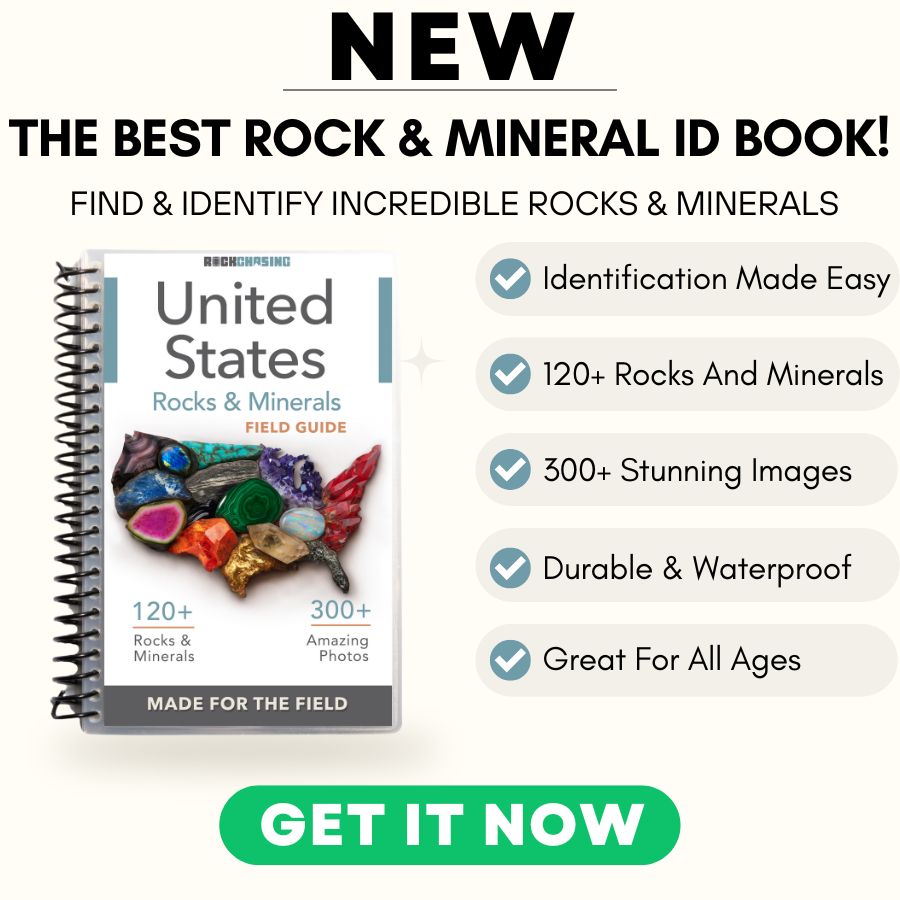Across the deserts and canyons, crystals in Arizona rest just beneath layers of dust and stone. The state holds countless spots where mineral-rich ground has revealed its treasures over time.
Clear quartz, smoky variations, and colorful mineral clusters reflect the variety hidden within the landscape. Each discovery feels like uncovering a bright piece of the earth’s past.
Once you learn which environments reveal the best stones, your chances of success rise quickly. A little knowledge can turn an ordinary walk into the beginning of a remarkable collection.
- The extensive local experience and understanding of our team
- Input from multiple local crystal hunters and crystal collecting groups
- The accessibility of the crystal mining locations
- Safety and potential hazards when collecting
- Private and public locations
- A desire to include locations for both experienced crystal hunters and those who are just starting out
Using these weights we think we’ve put together the best list out there for those who love finding new crystals for our collections!
The Types of Arizona Crystals You Can Find
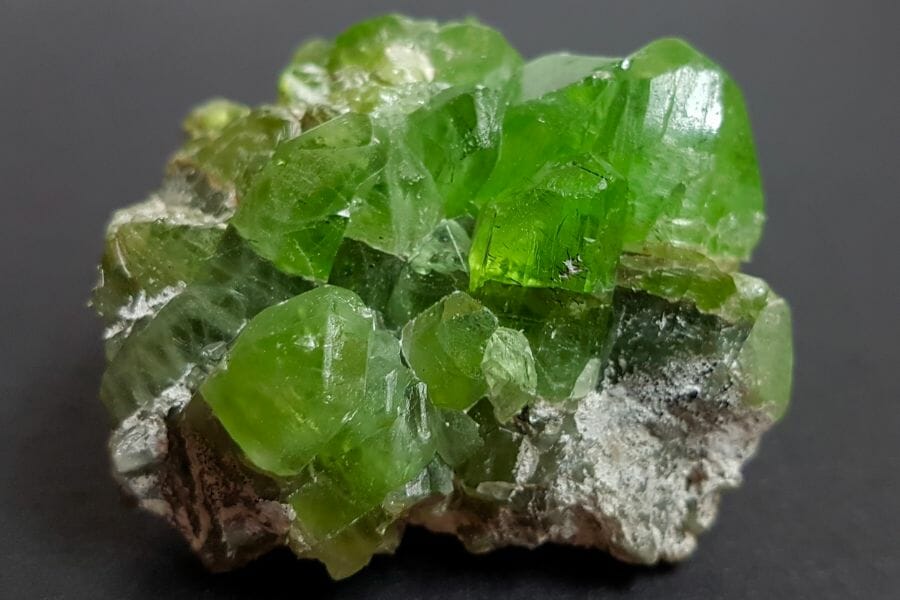
Crystals are natural mineral formations that grow into a range of unique shapes and colors, admired for their beauty and symbolism for centuries. And Arizona is home to a rich variety of crystals, making it a popular destination for crystal mining. Below are some of them:
Bornite
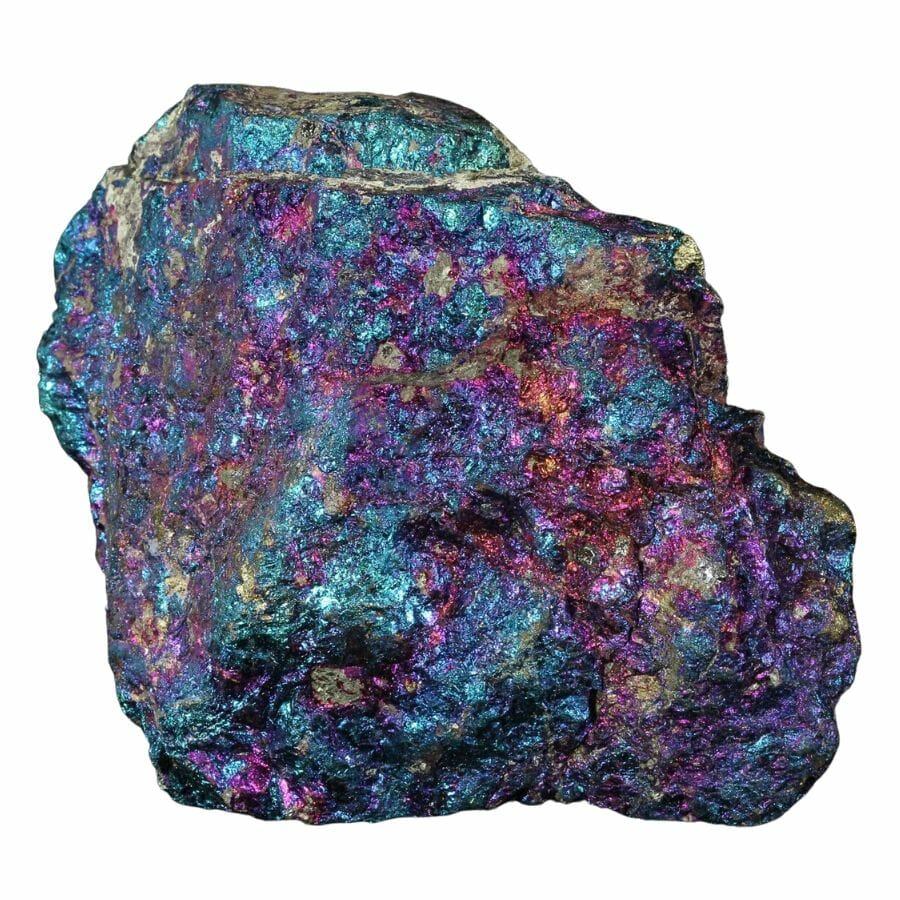
Bornite is an amazing mineral that sometimes goes by a super fun name: “peacock ore!” When you see it, you’ll totally get why. It flashes colors like purple, blue, and pink when it tarnishes, much like a peacock’s flashy feathers!
This mineral typically forms in igneous rocks. These are rocks that come from cooled-down magma or lava. Now, if you mix that with water containing certain minerals, and let them all react, bornite starts to form.
Arizona provides just the right setting for bornite to develop. That’s why if you explore the state, there’s a good chance that you’ll come across bornite.
This mineral’s dazzling colors make it a favorite among mineral collectors. It’s like having a little rainbow in a rock!
But that’s not all. Bornite is also an important ore for copper. That means we can extract copper from it, which we use in all sorts of stuff like wires and coins.
Where you can find bornite in Arizona
- Superior area, Superior Mining District
- Golden Rule Mine, Dragoon District
- Copper Queen Mine, Mayer, Agua Fria Mining District, Bradshaw Mountains
Pyrite
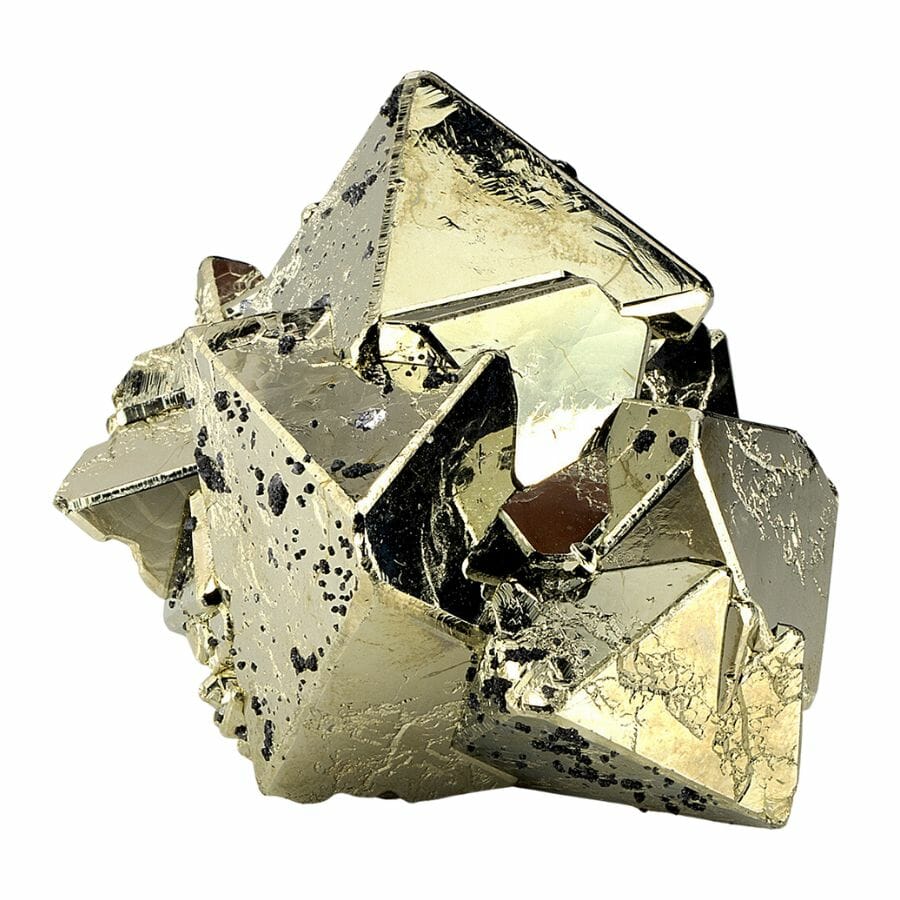
Pyrite is often called “fool’s gold” because of how similar it looks to the precious metal. It might trick you with its shiny, gold-like appearance, but it’s a unique and awesome mineral all on its own.
This mineral forms when iron and sulfur bond together under certain conditions. It can grow in all sorts of places like sedimentary rocks, volcanic rocks, and even in coal beds.
Arizona, with its diverse geology and plenty of underground magic, provides some excellent spots where pyrite can form. That’s why the variety of crystals found in Arizona attracts both seasoned geologists and curious explorers alike.
Aside from its cool, golden shimmer, pyrite has some other neat uses. Long ago, people used it to create sparks, kind of like an ancient lighter.
Also, because of its metallic look, it’s a hit among mineral collectors and is often used in jewelry and decorations.
Where you can find pyrite in Arizona
- Jack White Mine, Winifred Mining District, Phoenix Mountains
- Black Mesa, Mohave County
- Black Pearl Mine, Loco Creek, Eureka Mining District
Quartz

Quartz is clear and sparkly, but it can also come in a rainbow of colors, from pretty purples to rosy pinks and even smoky browns.
It loves to grow in cracks and spaces inside rocks. When hot water filled with dissolved minerals moves through these spaces and then cools down, quartz starts to crystallize.
Think of it like sugar crystallizing in a supersaturated solution to make rock candy.
Arizona has a lot of varied landscapes and a lot of geothermal activity, which is why you’ll find quite a bit of quartz here.
Quartz is super versatile. You can find it in everyday items like watches, and it even helps power electronics.
People have also been using quartz for jewelry for ages. Its sparkle and variety of colors make it a big hit. Plus, many believe that different types of quartz have special energies or healing properties.
Where you can find quartz in Arizona
- Castle Hot Springs
- Coolidge Dam
- Agua Fria River (stream), Bradshaw Mountains
Wulfenite
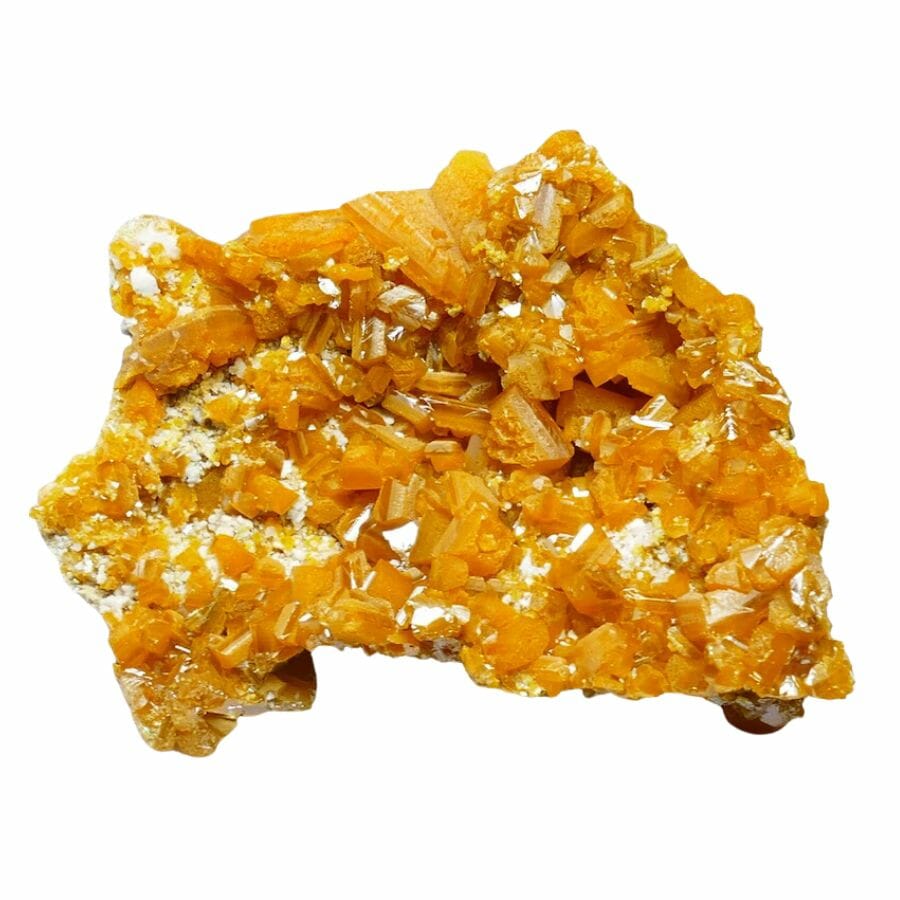
Wulfenite is a true attention-grabber with its bright orange and yellow colors. It forms in flat, square-shaped crystals that sometimes look like little windows.
Arizona, known for its rich array of rocks and minerals, is a good place to look for wulfenite. In fact, it’s the state mineral!
Wulfenite forms in what geologists call “oxidized zones” of lead deposits. That’s a fancy way of referring to areas where lead has reacted with oxygen and other things over time.
When conditions are just right, with the perfect mix of elements and the right environment, wulfenite starts to crystallize.
With its bright colors and cool crystal shapes, wulfenite is a favorite for mineral collectors. And while it’s not used much industrially today, in the past, it was an important ore for getting lead and molybdenum.
Where you can find wulfenite in Arizona
- Rustler Park, Cochise County
- Pope Mine, Mohave County
- Junction Mine, Gold Basin Mining District, White Hills
Covellite
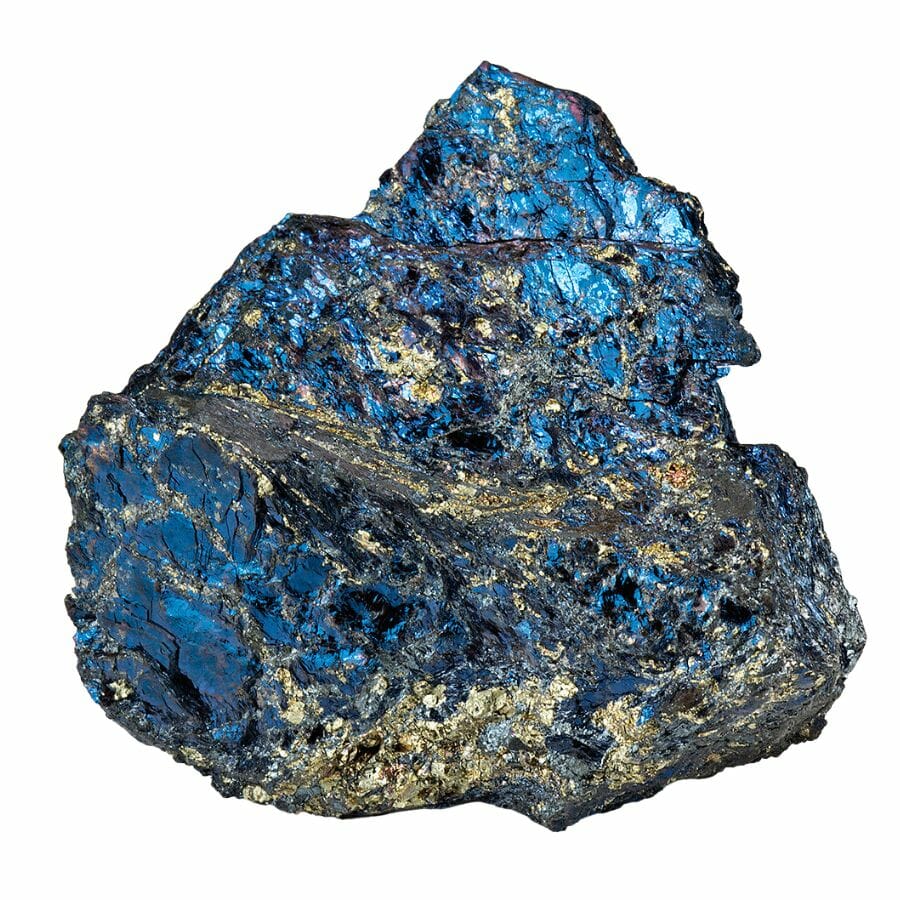
Covellite has a unique dark blue-purple sparkle that makes it stand out in the rock crowd. It’s like a splash of midnight sky wrapped in a stone.
When copper minerals are exposed to water and oxygen, they can change or “oxidize.” As the copper minerals transform, they can turn into covellite. This process takes a really long time, but it’s worth the wait!
With Arizona’s rich history of copper mining and its unique underground conditions, it’s no wonder that covellite can be found here.
Covellite’s deep blue-purple sheen makes it a favorite among rock collectors. Imagine having a piece of the night sky in your hand! Plus, jewelers often use it to create eye-catching pieces.
On top of looking amazing, some folks believe that covellite can boost creativity and help with communication.
Where you can find covellite in Arizona
- Aravaipa Mining District, Graham County
- Rowley Mine, Theba, Painted Rock Mining District, Painted Rock Mountains
- Boss Mine, Goodsprings Mining District, Spring Mountains
Dioptase
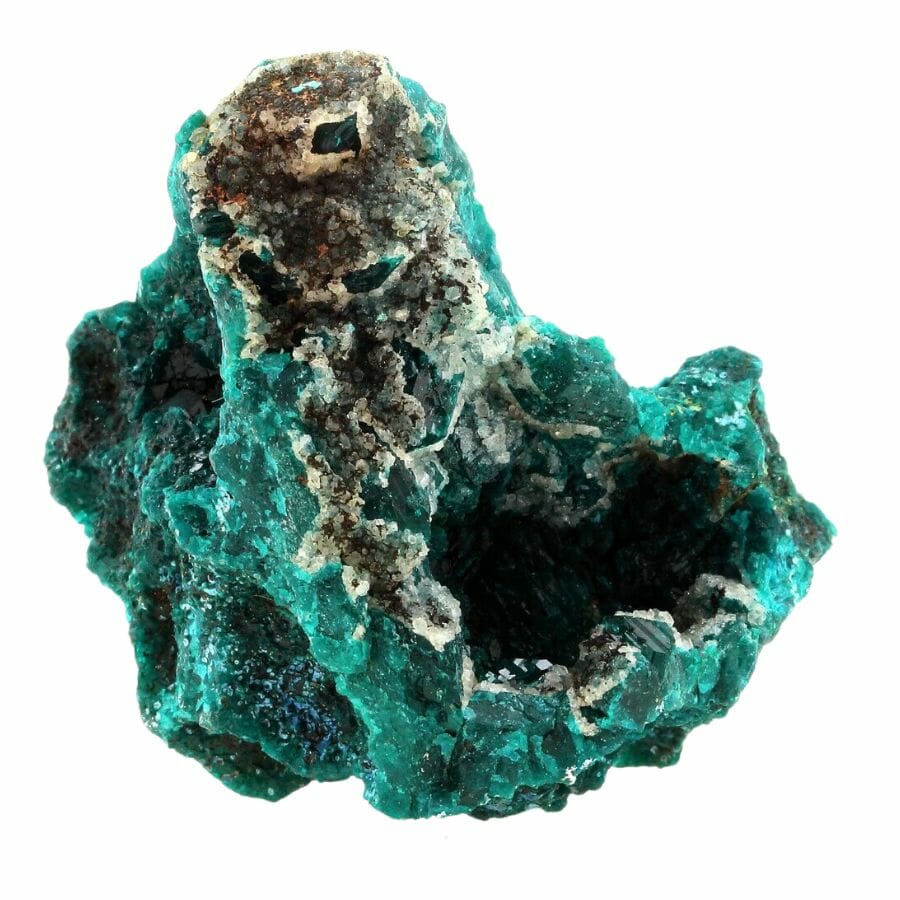
Dioptase, with its vibrant green sparkle, is one of the most eye-catching crystals found in Arizona. Imagine a gem with the vibrant green of a rainforest, and you’ve got dioptase!
This mineral is born when copper-rich water reacts with silica and certain conditions deep in the Earth. This special mix, under the right temperature and pressure, creates those stunning green crystals.
Arizona, with all its awesome geothermal activities and copper deposits, is just the right kind of place for dioptase to grow.
Dioptase’s brilliant color is a total crowd-pleaser. Mineral collectors go bananas for it. Plus, while dioptase looks like an emerald, it’s actually way rarer, which makes it super special.
People also value it for its healing properties. Some believe that this gem can bring peace, balance, and emotional healing.
Where you can find dioptase in Arizona
- Bonanza Mine, Bonanza and Golden Eagle Mine group, Martin Peak, Salome
- Johnson Camp, Gunnison Copper Project, Cochise Mining District
- Eagle Eye Mine, Moore Mine group, New Water Mining District, New Water Mountains
Selenite
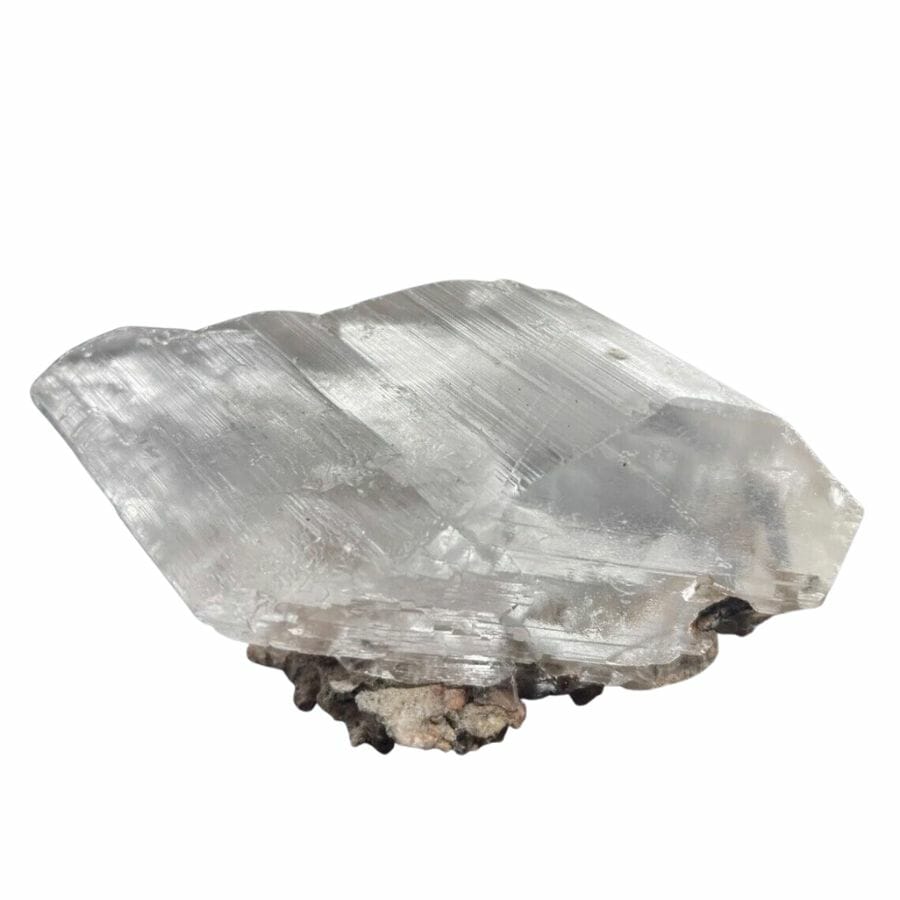
Picture a crystal that’s so clear and sparkly, it looks like frozen moonlight. That’s selenite for you!
Selenite is a type of gypsum, and it loves to form in watery spots, like salt flats or areas that once had ancient lakes. When water evaporates from these places, selenite starts to crystallize.
Arizona, with its deserts, once-upon-a-time lakes, and unique below-the-ground conditions, is a dream home for selenite to grow.
Those clear, shiny crystals can grow super big, making them a hit among people who love collecting minerals. Plus, it’s sometimes used in decoration because of its lovely glow.
Selenite is also popular for its peaceful energy. Many believe that it can clear negative vibes and bring calm to a space.
Where you can find selenite in Arizona
- Toltec Divide Area Gypsum deposit, Winslow, Winslow Mining District
- Lucky 44 claim, Mohave County
- Monument No. 2 Mine, Monument No. 2 channel, Yazzie Mesa, Cane Valley Mining District
Azurite

Azurite is one of the most eye-catching rocks and minerals found in Arizona. It’s this cool, bright blue stone that looks like it’s borrowed its color straight from a summer sky.
Azurite is made up of copper, carbon, and oxygen. When you think of copper, you might picture shiny pennies. But in nature, copper can combine with other elements and make beautiful minerals like azurite.
The process usually starts in places where there’s copper-rich rock. When water and air get to this rock, they help create azurite. It often appears in cracks, crevices, and spaces where the water can flow and leave behind the vibrant blue mineral.
And sometimes, you might find it hanging out with its green buddy, malachite. Together, they create a stunning duo!
Azurite’s brilliant blue has caught people’s eyes for ages. In the old days, artists ground it up to make a vivid blue paint. Today, collectors and jewelers still love it for its striking color.
Where you can find azurite in Arizona
- Rosalie Mine, Brooklyn Peak
- Yuma Mine, Ellsworth Mining District
- Mammoth-Saint Anthony Mine, St. Anthony deposit, Tiger, Mammoth Mining District
Calcite

Calcite is like the chameleon of the rock world because it can be found in a rainbow of colors, from clear to yellow, pink, and even green! Its looks can vary, but it’s always made of calcium, carbon, and oxygen.
Here’s the cool part about how calcite is made: It often forms from the remains of ancient sea critters.
Over time, shells and bits of coral pile up on the ocean floor. Pressure from the layers above squeezes them all together and, voila, we get calcite!
But that’s not the only way. Calcite can also form in caves as water drips down, leaving behind minerals that build up as stalactites and stalagmites.
This mineral is not only pretty to look at but is also super useful. It’s been used in construction and to make cement.
Arizona, with its rich geology, has been a cool spot for finding calcite. From cave formations to ancient sea beds, this state is a treasure trove for mineral enthusiasts.
Where you can find calcite in Arizona
- Henrietta Mine, Big Bug Mining District, Bradshaw Mountains
- Cypress Mine, Bagdad, Eureka Mining District
- Big Sandy Valley, Mohave County
Chalcedony

Chalcedony is a type of quartz, and it has this cool, waxy luster. It can show up in many colors, but often it’s found in dreamy blues, milky whites, and sometimes even a mix of colors.
Let’s break down the magic of how it’s made: imagine water flowing through tiny cracks and holes in the ground, carrying with it little bits of silica. As the water dries up, the silica left behind starts to form crystals.
Over a long, long time, these tiny crystals band together and become chalcedony.
Besides being easy on the eyes, people have loved and used this stone for ages. Jewelers adore it for its smooth, glowy look, perfect for creating dazzling jewelry pieces.
And let’s not forget, some folks believe chalcedony can balance emotions and bring a sense of peace.
Arizona offers a perfect home for chalcedony. The state’s rich geology paints a canvas of colors and stories in the form of minerals. Chalcedony is one such tale of time and beauty.
Where you can find chalcedony in Arizona
- Anna Bernice claims, Joseph City
- Mac No. 3 prospect (Mac #3), Sun Valley, Petrified Forest Mining District
- Agua Fria River (stream), Bradshaw Mountains
Chrysocolla
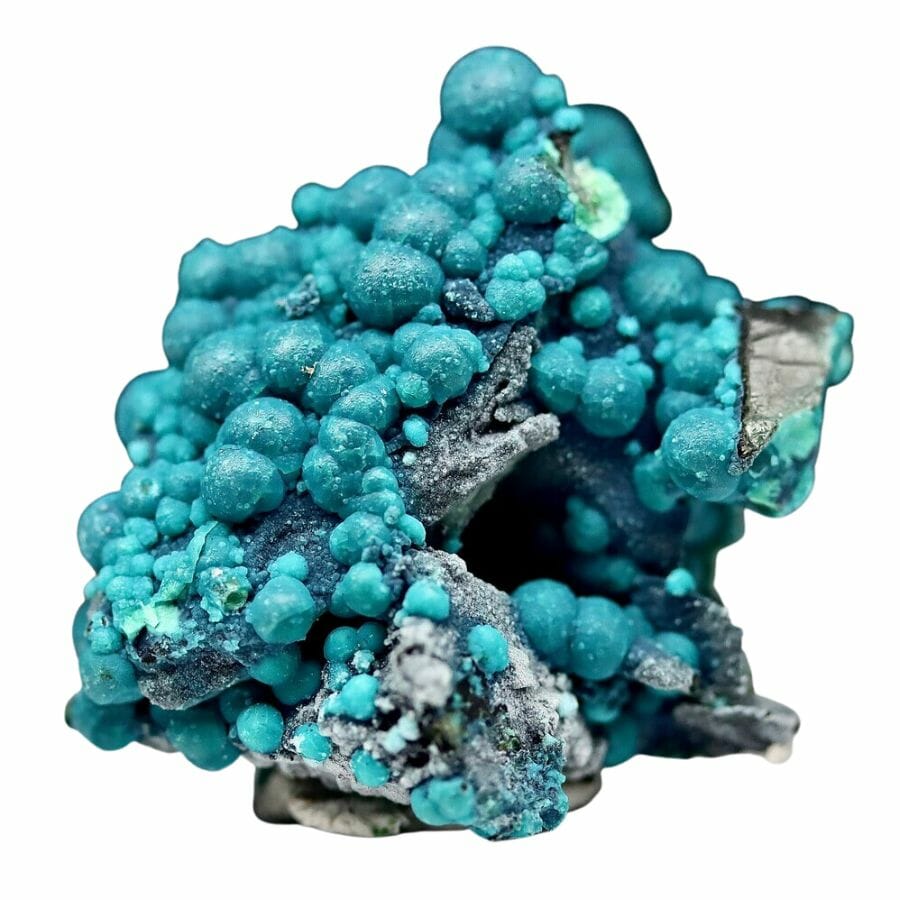
Chrysocolla is known for its eye-catching blue and green colors, kind of like a mix between the sky and a cactus! It’s closely linked with copper, which is a big deal in Arizona. This copper connection is the secret behind chrysocolla’s cool colors.
When rainwater meets copper-rich rocks, it helps break down the copper. As the water moves, it carries the copper along with it. Over time, the copper combines with other stuff like silica, and together, they form chrysocolla.
The resulting colors are absolutely enchanting. That’s why chrysocolla has been used to make jewelry that can make anyone stand out in a crowd.
On top of that, some people believe chrysocolla has calming vibes and can help with communication. It’s like having a pocket-sized peace buddy!
Arizona’s vast landscapes and deep copper mines make it a prime spot for chrysocolla. This mineral is a shining example of how the desert hides colorful secrets in its depths.
Where you can find chrysocolla in Arizona
- 79 Mine, Chilito, Hayden area, Banner Mining District
- Buckeye Copper Mine, Spring Mountain, Webb Mining District, Gila Bend Mountains
- Copperstone Mine, La Paz Mining District, Dome Rock Mountains
Fluorite
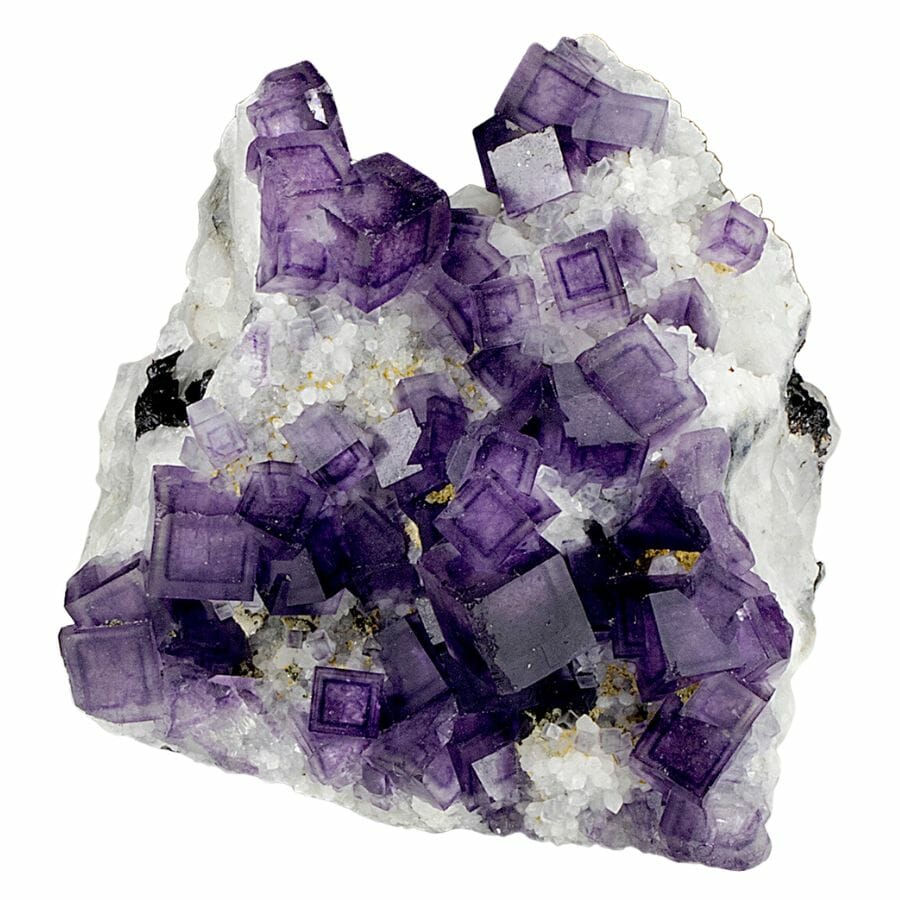
Alright, rock enthusiasts, let’s shine a light on the colorful world of fluorite! If you ever wished for a rainbow trapped in a stone, fluorite might just be that dream come true, especially in the rocky playground of Arizona.
Fluorite comes in a bunch of awesome colors. It can be purple, green, yellow, blue, or even clear! Sometimes, it mixes a few colors in one stone, making it look like a magical crystal.
So how does this colorful wonder come to be? Fluorite forms when hot water full of minerals flows through cracks in rocks. As the water cools down, the minerals start to stick together and form crystals.
Over a long time, these crystals grow bigger and become the fluorite we know and love.
Here’s a fun fact: fluorite can glow under ultraviolet light. Scientists value it for its role in scientific research, and collectors adore it for its unique and vibrant colors.
Where you can find fluorite in Arizona
- Old Spanish Mine, Pima County
- Pool’s Mine, Lee Mountain area, Saddle Mountain Mining District
- Black Pearl Mine, Loco Creek, Eureka Mining District
Shattuckite
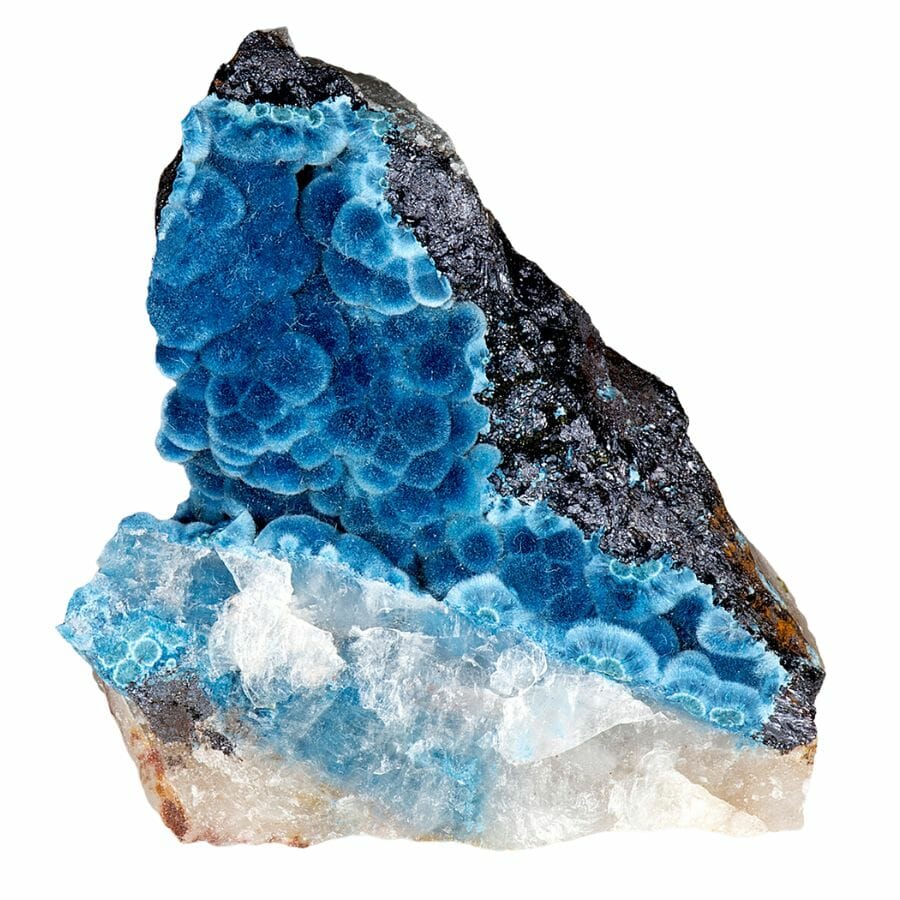
Shattuckite belongs to the copper silicate family. Now, if you’re wondering what that means, just think of it as a mix between the green of copper and the sandy touch of silica. Combine them, and you get this blue wonder!
In places where copper ores are found, there’s often a lot of water moving around underground. This water reacts with the copper, and together, they start forming new minerals.
As the mixture of copper and silica settles into spaces and cracks over time, shattuckite is born.
Arizona’s mineral-rich grounds provide the perfect setting for shattuckite to come to life. You can find it in various forms, from delicate coatings on rocks to stunning crystalline formations.
Shattuckite’s striking blue hue is simply mesmerizing. It’s no wonder why jewelers and rock collectors love it!
But it’s not just about the looks. Some believe that shattuckite has the power to enhance communication and intuition.
Where you can find shattuckite in Arizona
- Nugget Fraction Mine (Nugget Fracture property), Silver Reef Mountains, Tat Momoli Mountains, Silver Reef Mining District
- New Cornelia Mine, Ajo, Little Ajo Mountains, Ajo Mining District
- Eagle Eye Mine, Moore Mine group, New Water Mining District, New Water Mountains
- Shattuck Mine, Bisbee
Amethyst
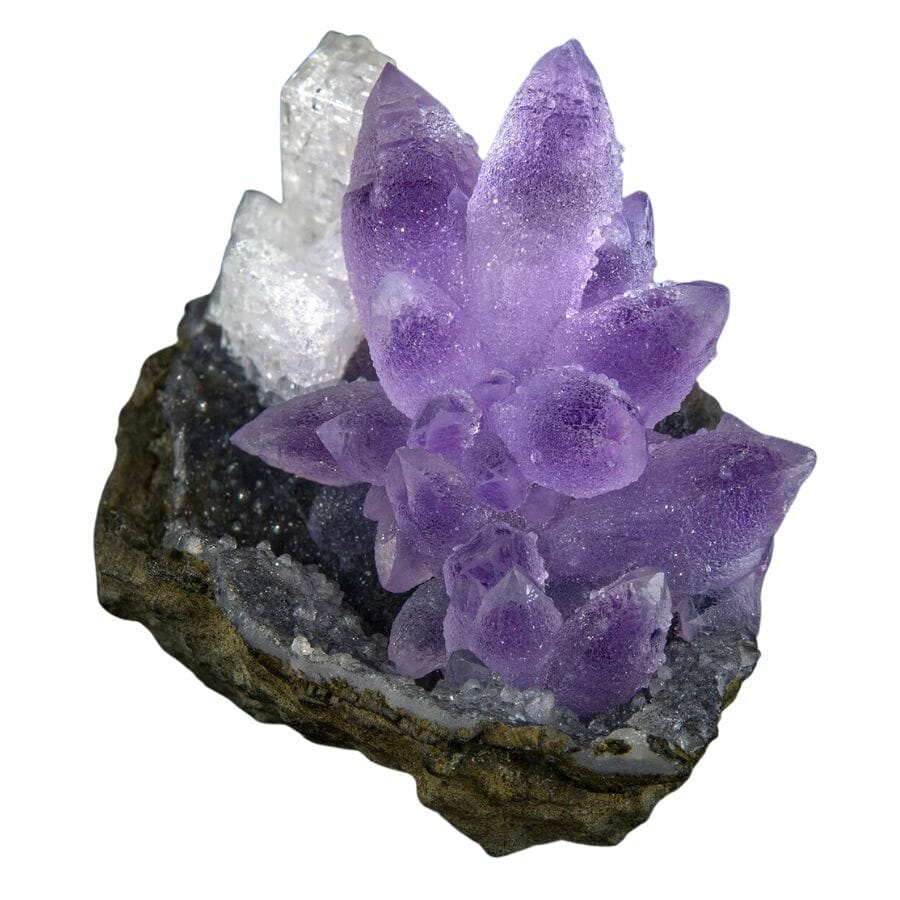
Imagine a stone that looks like the color of grape juice – that’s amethyst. It’s a type of quartz, which is a super common mineral, but what makes amethyst special is its pretty purple color.
Amethyst forms deep beneath the Earth’s surface. When hot molten rock called magma starts to cool down, it can form little pockets. Inside these pockets, there’s super hot water filled with all sorts of minerals.
Over time, as this water cools down and starts to move away, the minerals in the water begin to crystallize.
If the right mix of minerals is present, like iron, and if it gets exposed to the right amount of radiation from the rocks around it, we get the gorgeous purple amethyst.
Arizona is a special place for amethyst because the conditions there are just right. The state has plenty of volcanic activity in its past, which created a lot of those underground pockets where amethyst could form.
Many believe that amethyst has healing properties. It’s also been used in jewelry for thousands of years. Whether you believe in its powers or just love the way it looks, there’s no denying that amethyst is a rock star in the world of minerals!
Where you can find amethyst in Arizona
- Maricopa Mining Corp. Mine, Four Peaks
- Date Creek, Congress Junction area, Martinez Mining District, Date Creek Mountains
- Cameron, Cameron Mining District
You can check out this guide to discover more spots where you can find amethyst:
Peridot
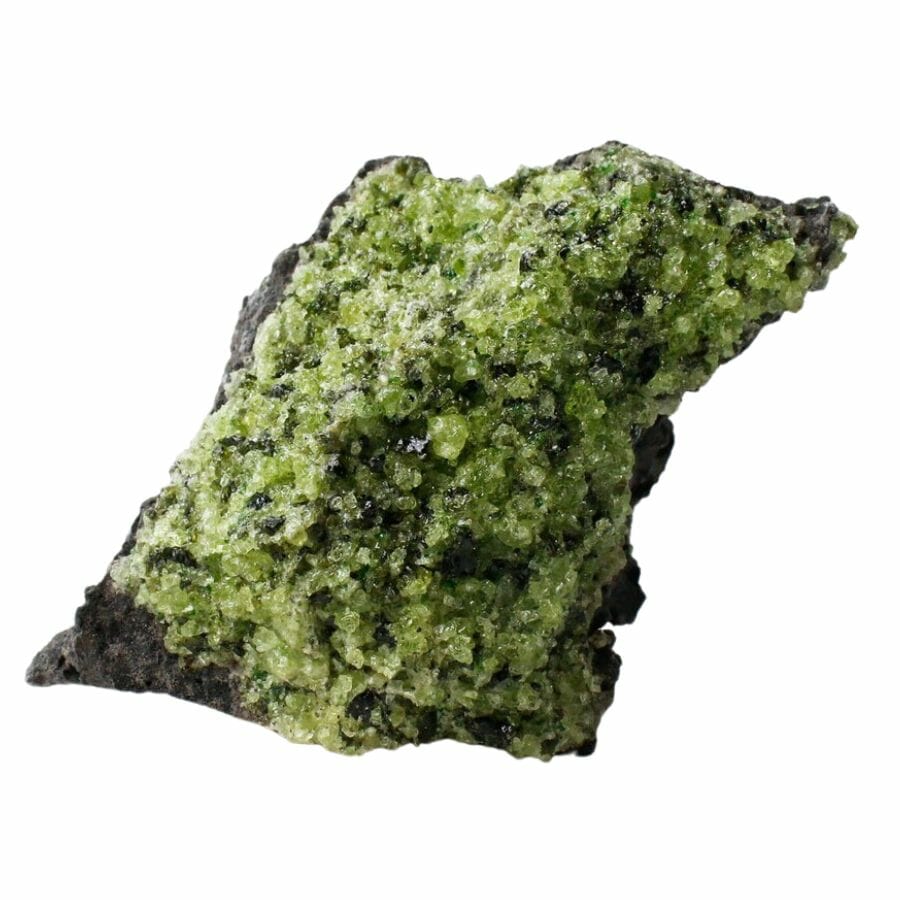
Among the many rocks and minerals found in Arizona, peridot stands out with its vibrant green sparkle. It’s a zesty, brightly colored gem that dazzles in the sunlight.
What’s cool is that peridot is one of the few gems that only comes in one color. But it can range from a yellowish-green to a deeper olive shade.
Now, let’s get to the magical part: how it forms, especially in a place like Arizona. Deep down in the Earth, way below our feet, there’s a lot of heat and pressure. Under these extreme conditions, peridot crystals begin to grow in the molten rock.
Sometimes, this molten rock with peridot in it shoots up to the surface in violent volcanic eruptions. As the lava cools and hardens, voilà! We have rocks with peridot crystals inside them.
Arizona has a history of these volcanic activities, which is why it’s a hotspot for peridot.
Historically, peridot was cherished by ancient Egyptians and believed to keep away evil spirits. In modern times, many love it for its bright color, and it’s even the birthstone for August babies!
Where you can find peridot in Arizona
- San Carlos Apache Indian Reservation
- Peridot Mesa (Peridot occurrence 38), San Carlos
- Peridot Canyon, San Carlos
Aragonite
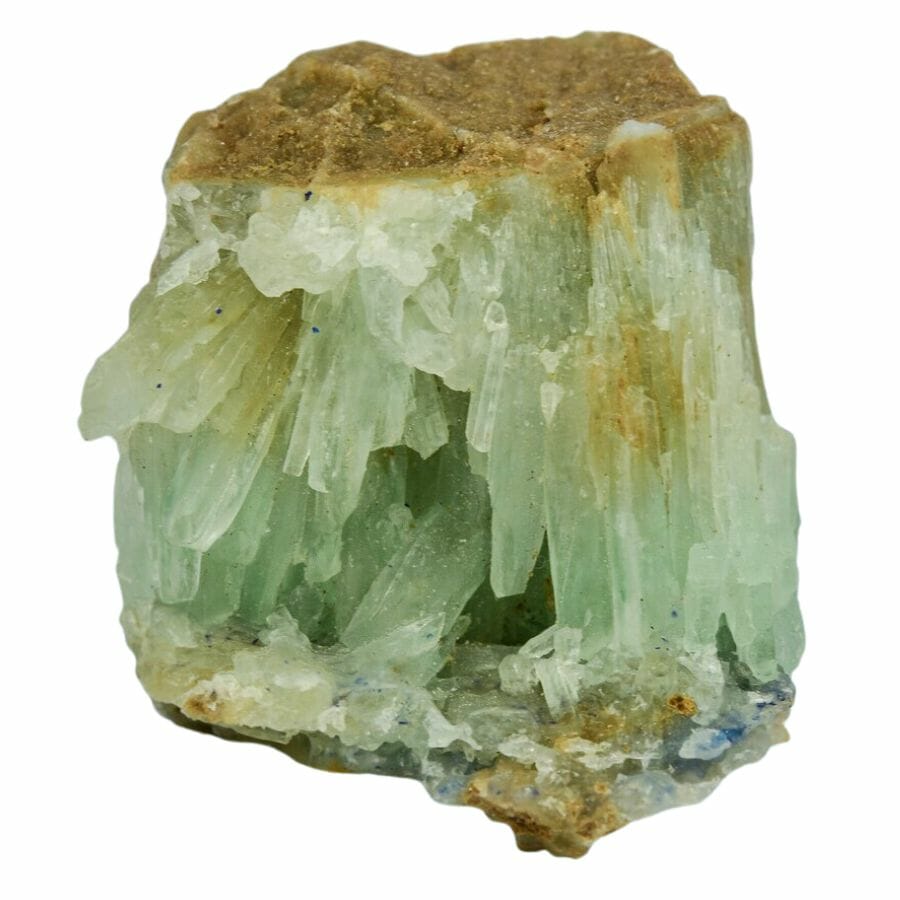
Aragonite might not have the fame of diamonds or rubies, but it’s a rockstar in its own right. Among the various types of rocks found in Arizona, aragonite stands out with its lovely crystal shapes.
It’s often white or clear but can sometimes sport shades like yellow, red, brown, and even a nice baby blue. It has a neat crystal shape, often looking like a burst of needles.
Aragonite forms in low-temperature environments like caves, hot springs, and even near certain salt lakes. When water with calcium carbonate drips in caves or evaporates in springs, it leaves behind these awesome aragonite crystals.
Arizona, with its varied landscapes, offers some sweet spots for aragonite formation. Its caves and hot springs have just the right conditions for this mineral to show up and show off.
Aragonite’s unusual crystal shapes are a big part of its charm. It’s often used for jewelry and decorations, and those who collect minerals find it a must-have for their collection.
Some even believe that aragonite has special energy or healing properties.
Sometimes, it’s also crushed up and used as substrate in aquariums because it helps balance the water’s pH level, making it great for fishy friends.
Where you can find aragonite in Arizona
- San Francisco River area, Clifton
- Copper Canyon, Camp Verde, Camp Verde Mining District
- Silver Bell Mine, Mineral Mountain, Silver Bell Mining District
The Best Locations For Crystal Mining in Arizona
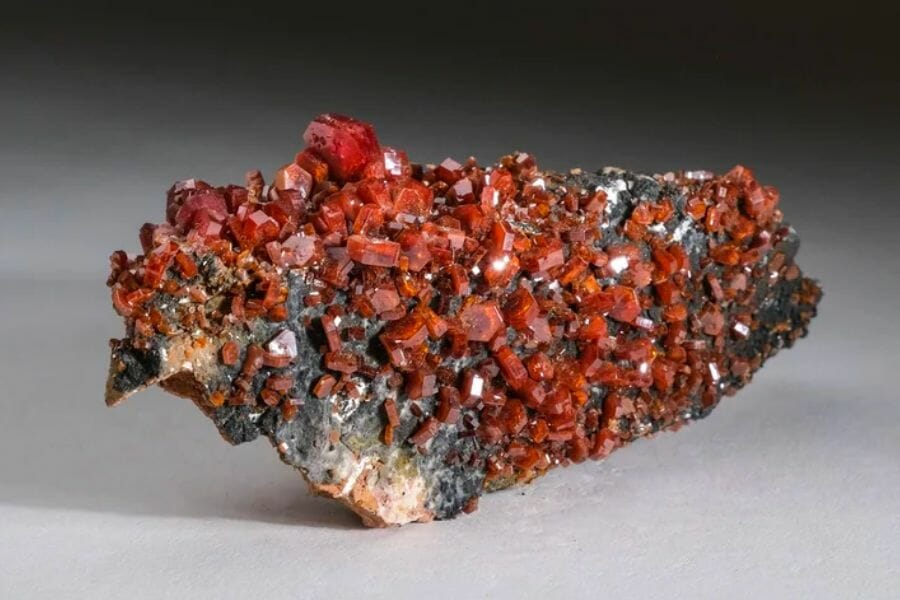
We’re sharing our top 5 recommended places for crystal hunting in Arizona. During our visit, these are where we had the best success finding crystals, and we’re hoping you’ll experience the same, too!
Always Confirm Access and Collection Rules!
Before heading out to any of the locations on our list you need to confirm access requirements and collection rules for both public and private locations directly with the location. We haven’t personally verified every location and the access requirements and collection rules often change without notice.
Many of the locations we mention will not allow collecting but are still great places for those who love to find beautiful rocks and minerals in the wild without keeping them. We also can’t guarantee you will find anything in these locations since they are constantly changing.
Always get updated information directly from the source ahead of time to ensure responsible rockhounding. If you want even more current options it’s always a good idea to contact local rock and mineral clubs and groups
Agua Fria River is Our Favorite Crystal Mine in Arizona
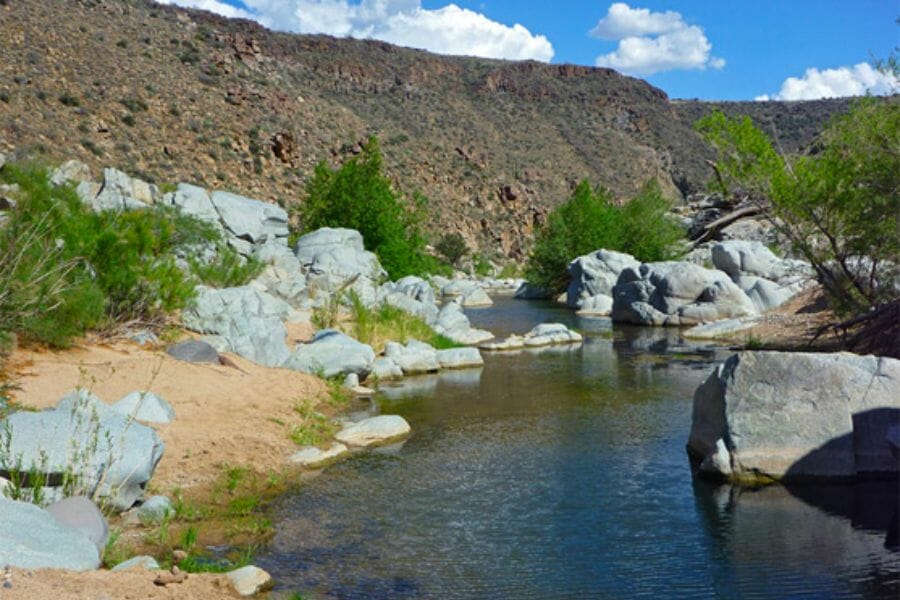
Avondale, AZ
The Agua Fria River has a rich history, having been inhabited by various indigenous groups for thousands of years. Today, it’s a popular spot for outdoor enthusiasts and rockhounds looking to explore its diverse geology. In fact, it’s one of the best places to mine gems in Arizona.
The river flows for approximately 120 miles through central Arizona, with its headwaters located in the Bradshaw Mountains. The river runs through a variety of landscapes, including desert canyons, riparian forests, and grasslands. It’s this diverse geography that makes it a great spot for rockhounding, as you can find a wide variety of minerals and crystals.
Just take note that the area can be challenging to navigate, so it’s a good idea to bring a map or GPS device if you’re visiting. And, as always, make sure to follow Leave No Trace principles and respect the natural beauty of the area.
Where we found crystals around the Agua Fria River
You can find amazing samples of Agate, Chalcedony, and Jasper crystals if you travel on the road from Castle Hot Springs south along the Agua Fria River. From there, you can prospect anywhere on both sides of the river.
If you want REAL results finding incredible rocks and minerals you need one of these 👇👇👇
Finding the coolest rocks in isn’t luck, it's knowing what to look for. Thousands of your fellow rock hunters are already carrying Rock Chasing field guides. Maybe it's time you joined the community.
Lightweight, mud-proof, and packed with clear photos, it’s become the go-to tool for anyone interested discovering what’s hidden under our red dirt and what they've already found.
Join them, and make your next rockhounding trip actually pay off.
What makes it different:
- 📍 Find and identify 140 incredible crystals, rocks, gemstones, minerals, and geodes across the USA
- 🚙 Field-tested across America's rivers, ranchlands, mountains, and roadcuts
- 📘 Heavy duty laminated pages resist dust, sweat, and water
- 🧠 Zero fluff — just clear visuals and straight-to-the-point info
- ⭐ Rated 4.8★ by real collectors who actually use it in the field
Neptune Mine
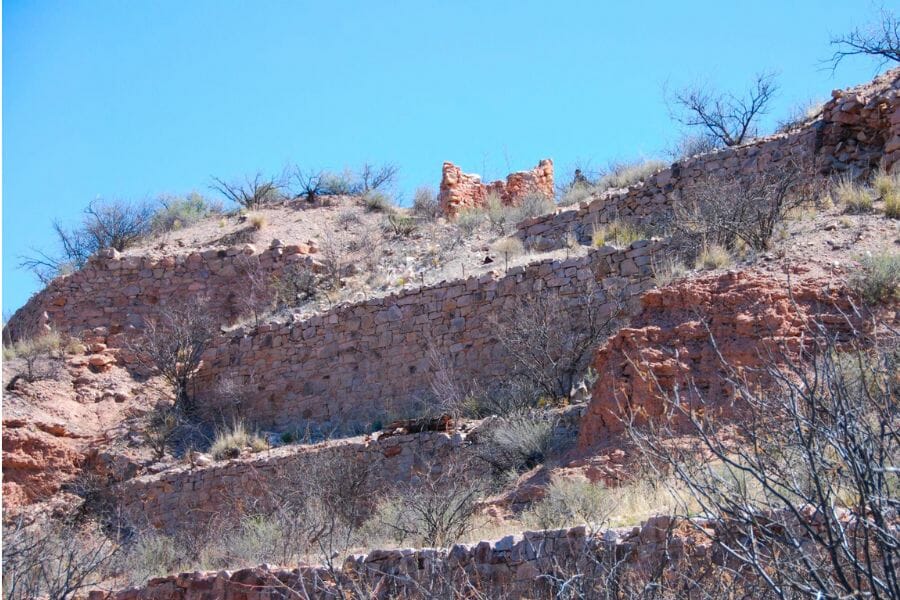
Pima County, AZ
The Neptune Mine is located in the Mineral Mountains of western Arizona and was originally discovered in the early 1900s. It was primarily a copper mine, but also produced other minerals such as silver, gold, and lead. The mine was active until the 1970s, and since then has become a popular spot for rockhounding and crystal collecting.
The Mineral Mountains, where Neptune Mine can be found, are part of the larger Basin and Range Province of our state. This area is characterized by rugged terrain, deep canyons, and arid landscapes. It’s rich in different varieties of minerals, making it a prime spot for crystal hunting.
In fact, you can find a wide diversity of crystals here, including some rarer ones, that you can uncover through surface collecting and digging. So if you want to visit here, be sure to bring along some basic tools like a rock hammer, chisel, and gloves. And don’t forget to dress appropriately for the desert terrain— you can’t have fun if you’re not prepared for this!
Where we found crystals at Neptune Mine
If you’re here, chances are you’re near crystals. That’s because Neptune Mine abounds with them. You can specially find Fluorite crystals if you explore the different areas of the mine. Know more about crystal prices by checking out our article!
Burro Creek
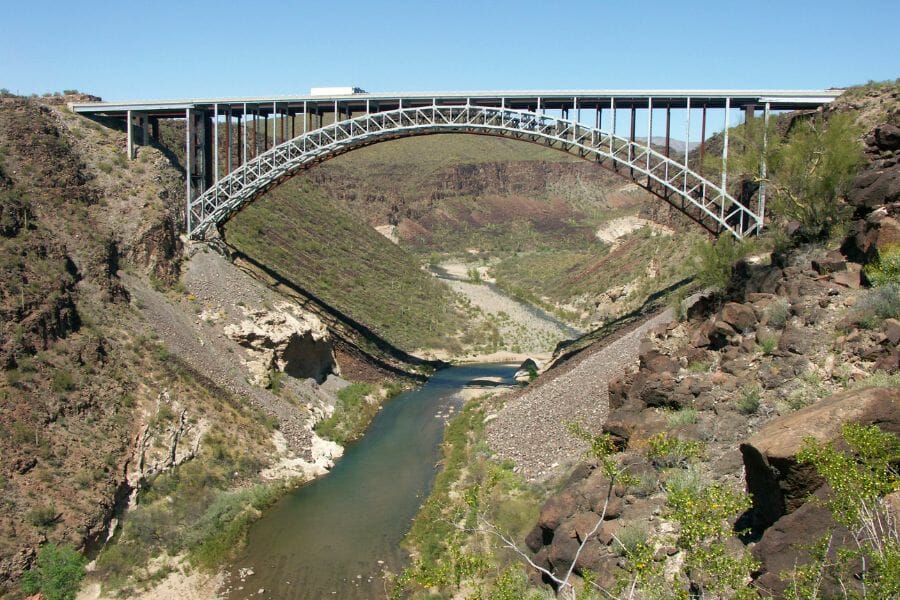
Wikieup, AZ 85360
Burro Creek is a must-see for rockhounds here! A tributary of the Bill Williams River, the creek is located in western Arizona. Its rich mining history dates back to the 1800s when gold was discovered in the region. The Burro Creek was an important water source for early miners and settlers, and today it is a popular destination for rockhounding and crystal collecting.
Since it’s located in the Sonoran Desert, which is characterized by rugged mountains, deep canyons, and a unique variety of flora and fauna, the geology of the creek is diverse with a mix of sedimentary and volcanic rocks. This makes it an ideal place for crystal hunting!
When visiting here, be sure to bring along some basic tools like a rock hammer, chisel, and gloves. We don’t want to explore this fantastic place without the right tools after all.
Where we found crystals at Burro Creek
We had the best of time finding Arizona crystals when we explored 15.75 miles southeast on US-93 to the bridge over Burro Creek. We collected a variety of these natural wonders downstream to the Black Canyon Mouth.
Ellison Creek
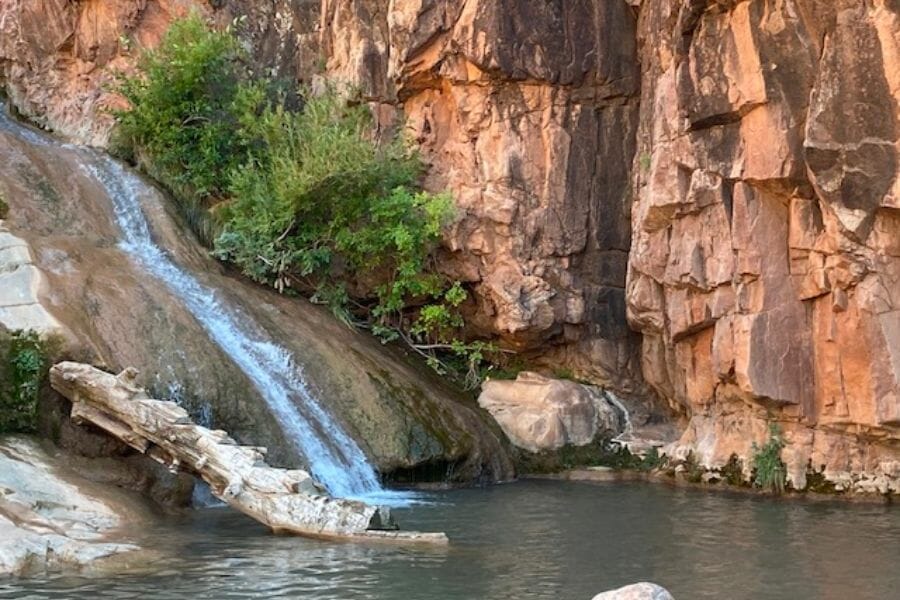
Gila, AZ 85541
The beautiful Ellison Creek is known for its stunning crystal formations, making it a popular spot for rockhounding enthusiasts. It’s located in the Tonto National Forest and was once a vital water source for the Native American tribes that lived in the area. Today, the creek is a popular spot for outdoor activities such as hiking, camping, and, of course, rockhounding.
Ellison Creek is a tributary of the East Verde River and it flows through a beautiful canyon surrounded by towering cliffs. The area’s geology is primarily sedimentary, with layers of sandstone and shale that have been uplifted and eroded over time. The rocks in this area are rich in minerals and crystals, too.
Suffice to say, Ellison Creek is a rockhound’s paradise with an abundance of beautiful crystals and minerals waiting to be discovered!
Where we found crystals at Ellison Creek
You can find great specimens of Agate, Jasper, and other mesmerizing crystals if you explore the area around Ellison Creek.
Oxbow Mine
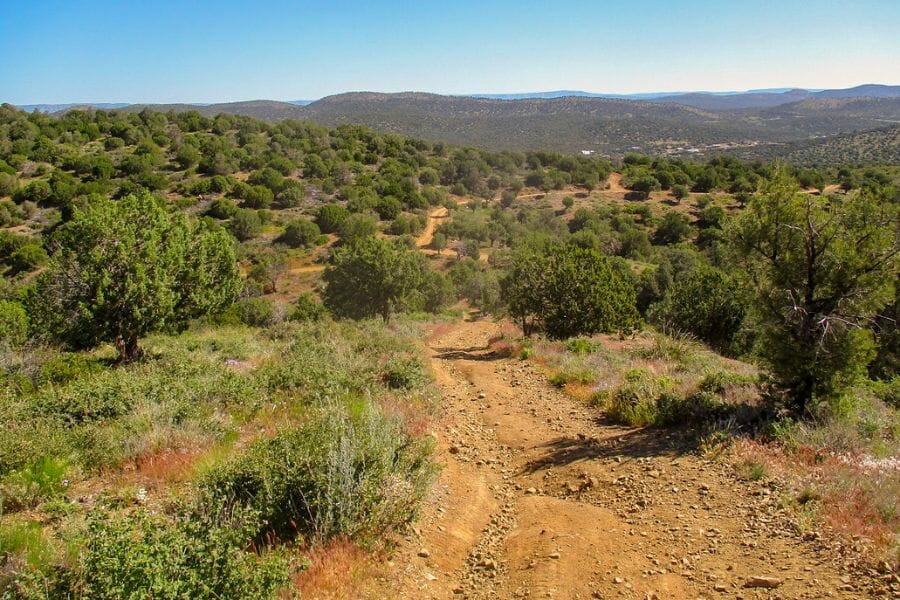
Gila County, AZ
The Oxbow Mine is located near the town of Safford. It was first discovered in the 1960s and was primarily used for copper and turquoise mining. However, in recent years, it has become known for its incredible mineral and crystal specimens.
The mine is situated in the Gila Mountains, which are a part of the larger Basin and Range Province. The area is characterized by its steep, rugged terrain, and unique geology. The rocks in this area are primarily volcanic, with layers of ash and tuff that have been weathered and eroded over time. This has resulted in the formation of stunning crystal deposits that can be found throughout the mine.
With this, the Oxbow Mine is a hidden gem for rockhounding enthusiasts because of its abundance in stunning minerals and crystals. If you’re visiting here, it’s important to note that the mine is located on private land, so it’s essential to obtain permission before exploring the area.
Where we found crystals at Oxbow Mine
We recommend that you explore the area copper mines of Oxbow Mine if you’re looking to find Copper, Epidote, Fluorite, and other equally stunning crystals here.
Our Other Favorite Places For Crystal Hunting
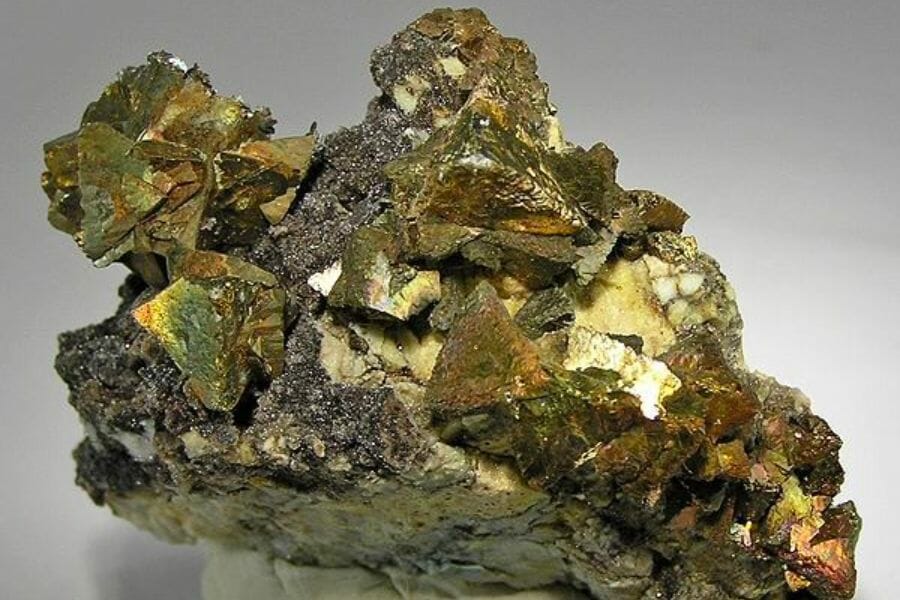
With a place as big and as rich in natural resources as ours, it’s no surprise that there are tons of other places for crystal mining here. In fact, you can even find Arizona geodes in some of these locations. Check these out:
Where you can find crystals for free in Arizona
For sure you know that, in most cases, the best sites to find crystals require some fee. However, there are equally amazing areas that you can explore without spending a dime. Here are some of them:
| County | Location |
| Apache | In the Chinle Formation at Echo Cliffs |
| Coconino | Downstream in Rogers Draw to Sand Creek |
| Gila | Southwest 2½ miles at Peridot Mesa |
| Graham | Along the Deer Creek Basin |
| Greenlee | North on US-666 to the first canyon on the left on Upper Eagle Road |
| Mohave | In the Cerbat Mountains, 1 mile east of Mineral Park on the slopes of Ithaca Peak |
| Navajo | Upstream in Oraibi Wash |
| Pinal | Downstream on the south bank of the Gila River |
| Yavapai | About 500ft. from the entrance of Cathedral Cave |
Other great places to dig for crystals
If you’re good with spending a few bucks to find and dig for Arizona crystals, we’ve also compiled some of the best recommendations here. Make sure to reach out out to first before visiting as the fees may vary depending on the season (or they may be free on certain seasons, who knows?!).
| County | Location |
| Cochise | At the Copper Queen Mine, Shattuck Mine, Arizona Mine, old Tiffany Turquoise Mine, Lucky Cuss Mine, and area mines of Gleason-Courtland District |
| Gila | At the Apache Mine, Global area copper mines, No. 79 Mine, Inspiration Mine, Keystone Mine, Live Oak Mine, Castle Dome Mine, Phillips Mine, Chrysotile Mine, and Silver Butte Mine |
| Greenlee | At the Detroit Mine and Manganese Blue Mine |
| Maricopa | Area of surrounding washes, draws, hillsides of Arizona Agate Mine |
| Mohave | Many area old mines like Little Kimball Mine |
| Pima | In the copper mines and pits especially in the New Cornelia Open Pit |
| Pinal | On dumps of Mammoth Mines and at the Olsen Mine |
| Santa Cruz | Many area mines of Duquesne, Patagonia District, Ruby, and Washington District |
| Yuma | Area mines of Castle Dome District |
How to find crystals in Arizona
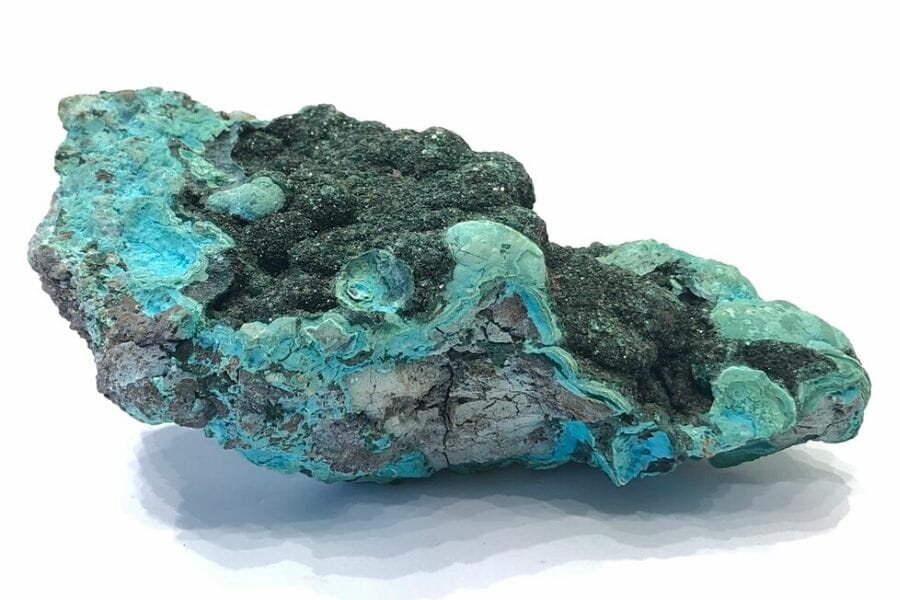
A handful of our recommended places above cover fairly large areas, so to help you focus your search, here are some of the usual locations that abounds in crystals. We highly recommend visiting these places first in your explorations:
Mines and Mine Dumps
Mines and mine dumps are locations where mining activity has taken place in the past. These sites are often rich in mineral deposits, which can be found in the form of crystals and gemstones. When miners extract minerals from the ground, they often discard the leftover material in a pile, known as a mine dump. These dumps can contain a wealth of minerals that were not of interest to the miners, making them a great place to search for crystals.
Streams and Creeks
Streams and creeks are natural waterways that flow through the landscape. As water travels through the earth, it can pick up minerals and carry them downstream. This can result in crystals and gemstones becoming deposited in the streambeds, making them a prime location for crystal hunting. Searching for crystals in streams and creeks can be so rewarding because, essentially, the water has done the hard work for you!
Rivers and River Banks
Rivers are natural waterways that often flow through mineral-rich regions. As water travels through the earth, it can dissolve and carry minerals with it. Over time, the water can deposit these minerals, including crystals, in the riverbed. This means that searching in rivers and riverbeds can lead you to some amazing crystal finds. And just like in streams and creeks, the water in rivers can help to uncover crystals that are buried in sediment or hiding under rocks.
Arizona Crystal Mining Laws And Regulations
Crystal mining is legal in Arizona, but it’s crucial to always abide by the local collecting laws of our state, especially the ones imposed by the Arizona Department of Mines and Mineral Resources (ADMMR) on public lands. Also make sure to obtain any necessary permits or permissions from concerned government offices or private individuals like the owner of any private land that you will explore. By respecting these local guidelines, you are helping ensure the sustainability of crystal mining in our state.
The Best Crystal Shops In Arizona
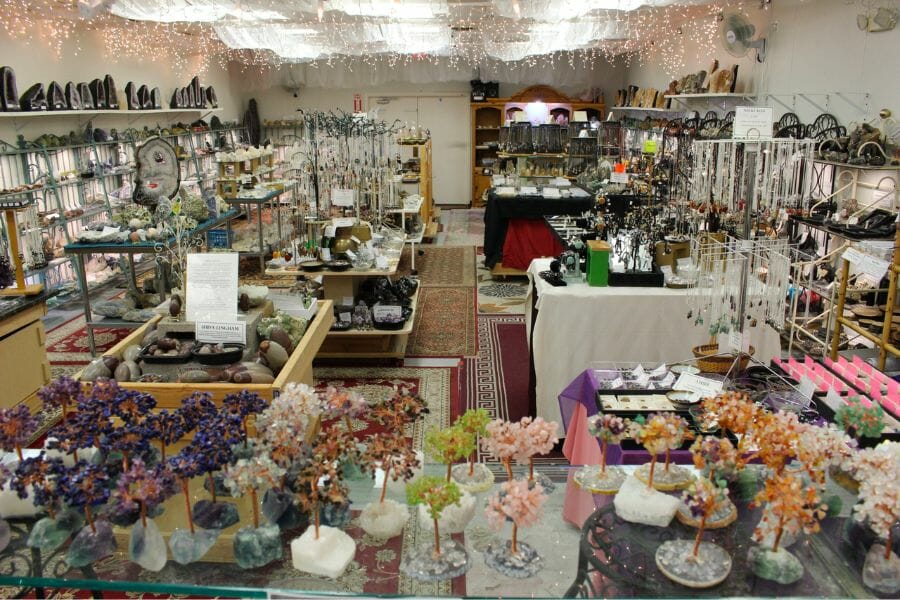
Crystal hunting isn’t exactly for the faint of heart, so if you prefer the chill way to find crystals here, better visit the local crystal shops here. What’s amazing about this is that you can often find rich varieties of crystals— including rare ones— in these shops:
- Fantasia Crystals – 5108 N 7th St, Phoenix, AZ 85014)
- Stones Crystal Shop – 7085 E 5th Ave, Scottsdale, AZ 85251)
- Everything Just Rocks – 2235 W 1st St Unit 104-105, Tempe, AZ 85281
- Black Market Minerals – 5000 S Arizona Mills Cir Suite 502, Tempe, AZ 85282
- Star Woman Crystals – near Scottsdale Rd &, E McKellips Rd, Tempe, AZ 85281
- Stardust & Sage Crystal Shop – 610 E Roosevelt St # 136, Phoenix, AZ 85004
- Forgotten Rarities – 64 N 45th Ave Suite A, Phoenix, AZ 85043
- Natural Expressions, Inc. – 13802 E Williams Field Rd, Gilbert, AZ 85295
- Buried Treasures Crystal Boutique – 16610 N 75th Ave Suite 105, Peoria, AZ 85382
- Serenity Rocks – 6055 E Southern Ave Suite 101, Mesa, AZ 85206
Additional places to find crystals in nearby states
If you’ve already tried all of our recommendations above or are planning a trip out of the state, you should check out our guides for neighboring states:
- Crystals in California
- Crystals in Nevada
- Crystals in Utah
- Crystals in Colorado
- Crystals in New Mexico
- Crystals in Alaska
If you have any recommendations we haven’t covered, please leave them in the comments below!



